The China Hutch: Design, Function, and History Guide
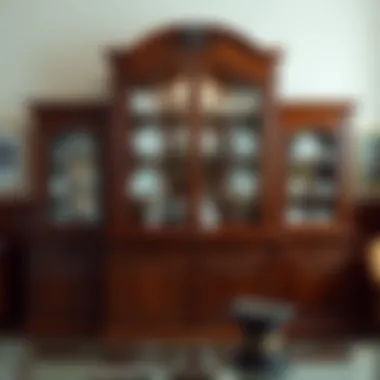
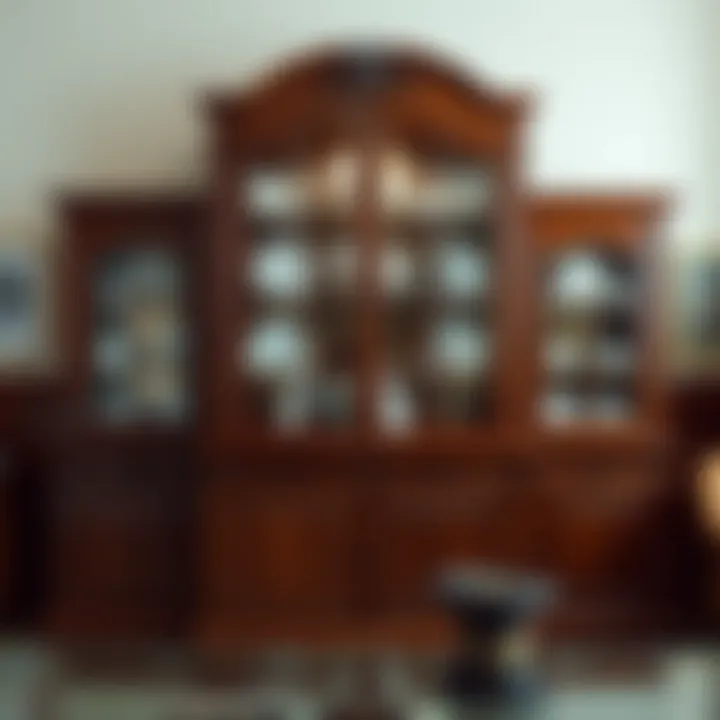
Intro
The china hutch is more than just a piece of furniture. It embodies a history steeped in culture, a blend of artistry, and evolving functionality in home design. Traditionally, these elegant display units served as cabinets for fine china and dining ware, often showcased with pride in dining rooms or family settings. However, their role has transformed significantly over time. Today, the china hutch represents a versatile component in modern decor, acting not only as storage but also as a statement piece that adds character to spaces.
Furniture Design Trends
The world of furniture design is ever-evolving. Keeping up with trends can be a daunting task for even the most seasoned designers and homeowners alike.
Current Trends in Furniture Design
A noticeable shift towards minimalism has occurred recently. Clean lines, simplistic forms, and functionality dominate current design trends. In this context, china hutches are being reimagined, often stripped of ornate detailing in favor of sleek, functional styles. Materials like reclaimed wood, metal, and glass populate modern interpretations, allowing for a more airy and open feel in homes.
- Emphasis on sustainable materials is another trend gaining traction. Furniture designers are leaning towards eco-friendly options, ensuring that materials used in hutches are sourced responsibly.
- Multi-functional furniture is also on the rise, with china hutches doubling as bookshelves or even room dividers, reflecting a shift in how people use their living spaces.
"Furniture is like art; a piece can transform an entire room and tell a story of its own."
Influential Designers to Follow
While trends are exciting, the vision of established designers often shapes them. A few standout names can guide homeowners and professionals in selecting pieces that resonate with contemporary aesthetics.
- Hans J. Wegner: His designs, like the famous Wishbone chair, influence how functional beauty is understood in modern design.
- Eero Saarinen: Known for his sculptural forms, his philosophy on merging aesthetics with practicality resonates with the design ethos of hutches today.
- Kathy Ireland: With a keen eye for accessible luxury, Ireland's furniture collections often feature pieces that blend traditional and modern styles seamlessly.
These designers offer a fresh perspective, encouraging individuals to think beyond conventional uses and embrace the beauty of innovative designs.
Practical Tips for Furniture Selection
When it comes to choosing the right china hutch for your home, several factors should be taken into consideration to ensure it serves its purpose well while complementing your interior aesthetic.
Choosing the Right Materials
- Wood: A classic choice, wood brings warmth and traditional elegance. Oak, cherry, and walnut are particularly popular for their durability and timeless appeal.
- Metal & Glass: For a contemporary look, metal frames combined with glass doors offer a lighter, more modern aesthetic, allowing items to be displayed while keeping dust at bay.
- Composite Materials: More affordable options, such as engineered wood, are increasingly popular as they can mimic the look of real wood without breaking the bank.
Selecting the right material can affect not only the hutch’s longevity but also how well it fits with your overall decor.
Maximizing Space with Smart Furniture Choices
- Size Matters: Measure your space before making a purchase. Opt for hutches that complement the proportion of your room.
- Functionality First: Consider models with adjustable shelves for storage flexibility. Others may have drawers or cabinets for added organization.
- Color Coordination: Choose colors that not only match but uplift the general scheme of your home. Neutral colors often work well for versatility.
By thoughtfully selecting pieces based on these guidelines, you can integrate a china hutch that is both practical and stylish into your home’s design.
Ending
The china hutch’s journey through time reflects broader cultural changes in domestic settings. It has transitioned from a glorified display case for fine china to a multifunctional piece that embodies modern design trends. Whether you’re an interior designer seeking inspiration or a homeowner looking to spruce up your space, understanding the significance of the china hutch goes a long way in making informed choices.
For further exploration into the history and evolution of the china hutch, you can visit Wikipedia or Britannica.
Foreword to the China Hutch
In the realm of interior design, few pieces carry the aesthetic and functional weight of a china hutch. This often-overlooked furniture piece serves as a bridge between practical storage and beautiful display. While one might think of it merely as a cabinet to store fine china, it stands as a testament to both craftsmanship and the culture surrounding dining and hospitality.
Understanding the china hutch's significance in the modern home involves peeling back layers of history, style variations, and the role it plays in our daily lives. This guide seeks to illuminate the multifaceted nature of the china hutch, helping homeowners and decorators alike appreciate its place in both traditional and modern settings.
Definition and Purpose
A china hutch, sometimes referred to as a china cabinet, is typically a tall piece of furniture featuring shelves equipped with glass doors. It is designed to showcase prized dishware and decorative items. At its core, the purpose of a china hutch extends beyond mere utilitarian function. It provides a way to display collections or heirlooms, transforming dining experiences into opportunities for storytelling.
For many, the hutch serves as a focal point in dining rooms or kitchens. It’s where memories are held—perhaps nestled within the hand-painted china sets gifted by relatives or unique pieces collected from travels. Moreover, the hutch also fulfills a practical purpose, offering storage for everything from glassware to linens, which highlights its dual functionality.
Cultural Importance
The china hutch is steeped in cultural significance that transcends its physical form. Within various cultures, the china hutch represents hospitality and the importance of gathering. Consider how, in many homes, the act of inviting guests to share a meal often involves showcasing the host's best dishware.
"A well-stocked china hutch is not just about aesthetics; it embodies hospitality, a warm welcome for friends and family alike."
Throughout history, the design of china hutches has evolved, mirroring societal values and trends. In colonial America, for instance, the hutch signified wealth and sophistication, serving as a display for imported goods and cherished possessions. In the eyes of many, this furniture piece reflects taste and a lifestyle commitment to home beautification.
In contemporary settings, china hutches remain relevant, adapted for modern aesthetics and lifestyles. Although less common in day-to-day use, these structures still convey a sense of personal history and connection to the past, making them irreplaceable in defining home interiors.
Knowing the depth of the china hutch's purpose and cultural relevance prepares individuals to choose or design one that not only meets their functional needs but echoes their personal stories and style.
Historical Overview
The historical overview of the china hutch provides a crucial backdrop for understanding its role in design and functionality. Insight into its past reveals not just a piece of furniture but a narrative of changing tastes, social customs, and evolving household needs. As we delve into this section, the significance of the china hutch becomes abundantly clear. It reflects not only aesthetic values but also cultural practices surrounding dining and hospitality.
Origins in Europe
The china hutch traces its roots back to the early modern period in Europe, around the late 17th century. It's an interesting tidbit that this furniture piece originally served as a storage unit for ceramics imported from China, hence its name. Wealthy families would display their fine china, silverware, and glassware in elaborately crafted cabinets, presenting them as symbols of status and refinement. In England, oak became the wood of choice, beautifully carved with intricate designs that conveyed the artistry of that era.
This tradition began in France with showcase units known as "vitrines," which combined functionality with opulence. The inspiration behind these pieces can often be traced to the burgeoning appreciation for craftsmanship and artistry during the Renaissance. As folks began to travel, they brought home unique pieces from the far corners of the world, and homes needed a dedicated place to exhibit such treasures. The hutch, with its glass doors and shelves, became the ideal solution for displaying these valuable items without subjecting them to dust.
In summary, the china hutch’s origin story reflects a historical context that highlights the interplay between commerce, art, and social status. It was never just about storing items but about making a statement—showcasing a family’s wealth and taste.
Evolution Over the Centuries


As we move through history, the design and purpose of the china hutch evolved alongside societal changes. The Victorian era, in particular, marked a significant shift. With the rise of the middle class, more people began adopting these storage units, but styles took on a more eclectic and accessible character.
Suddenly, ornate carvings fell out of favor, and simpler designs came into play, reflecting a growing emphasis on comfort and practicality. Many households, especially in rural areas, utilized more functional versions, making these hutches less of a luxury item and more an everyday necessity. This evolution aligned with the broader trends in furniture design—think about the mission style and its focus on straight lines and functionality.
Fast forward to the 20th century: the advent of mass production meant that more families could own these pieces without breaking the bank. Companies began to offer affordable variations, allowing a broader spectrum of styles, from the sleek lines of mid-century modern to the heavy, robust designs reminiscent of colonial America.
Today, the china hutch stands not just as a relic of the past but as a versatile piece in modern homes, serving various functions—storage, display, or even as a focal point in a room.
"Understanding the historical context of the china hutch enriches our appreciation of its role in both past and contemporary decor. It serves as a bridge connecting generations through the display and preservation of culture."
Therefore, the evolution of the china hutch parallels shifts in design philosophy, social structure, and even technological advancements, making it a subject worthy of exploration for contemporary decorators and homeowners alike.
Design Variations and Styles
A china hutch is more than just a storage solution; it serves as an important statement piece in interior design. Different styles can evoke distinct feelings or themes in a space, ranging from the cozy and rustic to sleek and modern. Understanding the various design variations can significantly add to the emotional and visual impact of a room. Whether you are a homeowner looking to spruce up your living space or a designer seeking the perfect accent piece, recognizing these options can lead to a deeper satisfaction with your choices.
Traditional Styles
Traditional styles can bring a sense of history and character to a space. These designs often reflect craftsmanship and detail that harken back to earlier times, making them popular among those who cherish elegance and artistry.
Queen Anne
The Queen Anne style features curved lines and intricate detailing, making it a popular choice for those wanting to add a touch of timeless elegance to their home. Characterized by its cabriole legs and shell motifs, Queen Anne hutches stand out for their warmth and sophisticated flair.
One notable characteristic is the use of dark woods, like walnut or mahogany, which imbue a cozy atmosphere while remaining durable. This style is a great fit for traditional homes but also mixes well in modern settings when contrasted with lighter décor. One downside is that the ornate details may not fit well in a minimalist or ultra-modern design.
Shaker
Shaker style embodies simplicity and functionality, focusing on practicality without unnecessary frills. Known for its clean lines and minimalist approach, a Shaker hutch often features straightforward geometry, which is appealing to both traditional and contemporary enthusiasts.
The beauty of Shaker design lies in its craftsmanship. Made primarily from pine and maple, these hutches often showcase the natural beauty of the wood with a simple finish, allowing the materials to shine. However, the understated design might lack the bold character some seek, which can limit its appeal in more ornate surroundings.
Nation Style
The Nation style reflects a rich blend of aesthetics influenced by various cultures, often incorporating unique materials and artistic elements. This versatile hutch is marked by detailed carvings and vibrant colors, allowing it to stand as an eye-catching centerpiece in any room.
An important aspect is the use of mixed materials, such as wood and metal, which can give it a distinctive look that can either contrast or complement existing décor. However, its vibrant patterns might not cater to everyone’s taste, which could lead to some design compatibility issues in more subtle interiors.
Modern and Contemporary Designs
Modern and contemporary china hutches focus on innovation and simplicity, integrating cutting-edge materials and sleek lines to redefine functionality in living spaces. They appeal to those seeking a fresh, functional, and stylish approach.
Sleek and Minimalist
The sleek and minimalist approach to hutch design typically features streamlined forms and a lack of ornamentation. This style is perfect for those who appreciate simplicity and want their storage piece to meld seamlessly with their décor.
Key features often include open shelving and sliding doors, making it functional while maintaining an uncluttered appearance. Its understated elegance can elevate modern or industrial spaces, though it may not satisfy individuals who prefer more decorative or intricate designs.
Industrial Influence
Hutches with industrial influence combine the robust, raw aesthetics of factory-inspired decor with warmth. They often use materials like reclaimed wood combined with metal accents, resulting in a striking visual contrast that speaks to both functionality and style.
This design resonates well with urban lofts or spaces that embrace a raw, rugged atmosphere. However, some may find it difficult to integrate such bold features into traditional spaces, which could be a consideration for various buyers.
Mid-Century Modern
Mid-century modern styles strike a balance between form and function, showcasing an emblematic design ethos from the late 1940s to the early 1960s. These hutches are often characterized by organic shapes and functional simplicity, and they tend to fit nicely in eclectic settings.
The key feature here is the mix of materials—think wood paired with metal legs—which gives them a timeless appeal. They can provide a retro vibe in more temporal homes, but may lack the intricate detailing found in more traditional designs.
Materials Used in Construction
Understanding the materials used in constructing china hutches is crucial for making informed decisions, whether you're a homeowner, interior designer, or real estate agent. The choice of materials not only affects the aesthetic appeal but also contributes significantly to the durability and functionality of the piece. With the right materials, a china hutch can serve not just as a display case but also as a practical storage solution that complements your interior design vision.
Solid Wood Varieties
The warmth and beauty of solid wood can elevate the overall design of a china hutch, making it a centerpiece in any room. Below are some common types of wood used in construction.
Oak
Oak is a classic choice for furniture, renowned for its strength and longevity. Its dense grain makes it a sturdy option, ideal for everyday use. One of its most notable traits is the unique patterns that appear in the grain, adding character and depth to the wood. Oak's durability means it's less likely to warp or crack over time, making it a sensible investment for a china hutch that you intend to use for many years.
However, while it is a robust option, oak can be on the pricier side. Choosing oak may stretch your budget, but its lifespan may balance out its initial cost.
Maple
Maple is another solid wood that has gained popularity for its fine, uniform texture. Its light color allows it to fit well into various styles—be it traditional or contemporary. One key characteristic of maple is its ability to resist scratches and dents, which is vital when storing delicate china or glassware.
The light hue of maple can brighten up a space, providing that clean and airy feeling many homeowners desire. Though it's usually more affordable than oak, the downside could be a susceptibility to yellowing over time under direct sunlight.
Cherry
Cherry wood stands out for its rich color that darkens beautifully with age, presenting a depth that few woods can match. It’s appreciated for its smooth texture and natural luster, making it a desirable choice for high-end china hutches. Cherry maintains a fine balance between beauty and functionality, ensuring that it adds elegance without compromising on strength.
One unique feature of cherry is its ability to take on a lovely patina with time. This can be a double-edged sword, though—while many people love how it ages, those who prefer a more consistent color might find the changes undesirable.
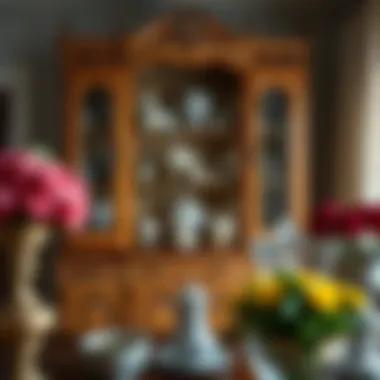
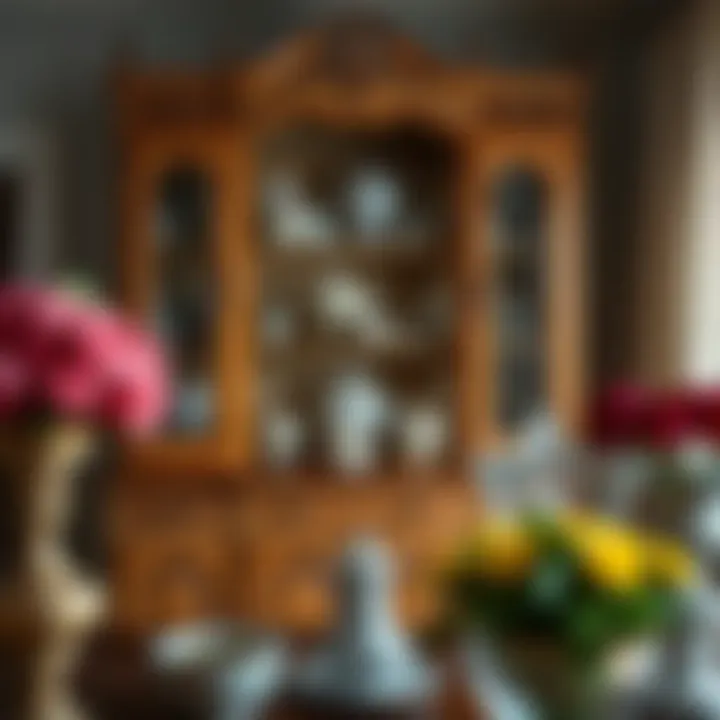
Alternative Materials
In addition to solid woods, several other materials can offer unique advantages for china hutches. These alternative materials may be considered for budget constraints or specific aesthetic preferences.
Glass
Glass is often used in the doors of a china hutch, showcasing the items stored inside while protecting them from dust. The transparency of glass provides a modern twist, allowing for a clear view of the hutch's contents. The inclusion of glass can make a piece feel lighter and spacious, an asset in smaller rooms.
However, glass can be fragile, requiring careful handling. A mishap could result in a broken door or shattered shelves, so keep this factor in mind when selecting a hutch with glass features.
Metal
Metal elements, whether as legs, handles, or decorative features can add an industrial touch to a china hutch. This material is known for its durability and might offer a striking contrast against wooden components. Many people leverage metal for modern designs, where sleek lines and utilitarian elements rule the aesthetic.
The downside? Metal can get cold to the touch and may not resonate with those seeking warmth in their furniture. It might also require more maintenance, as some metals can corrode or tarnish over time without proper care.
MDF and Veneer
MDF (medium-density fiberboard) and veneer are cost-effective alternatives often used in modern furniture, including china hutches. MDF is engineered to provide a smooth surface for finishes and paints, which can imitate the appearance of solid wood at a fraction of the cost.
However, while MDF can be less expensive, it is not as strong as real wood and may not last as long. Veneers, on the other hand, provide the look of a solid wood surface but are only a thin layer of wood glued onto a more affordable material.
In summary, the materials you choose for your china hutch can greatly influence its look and durability. Each option brings its own charm and functionality, allowing for customization based on personal needs and styles.
Functional Aspects
The role of a china hutch is not just confined to aesthetic appeal; it serves several important functions in modern homes. Understanding these functionalities can ultimately help homeowners and designers make educated choices when incorporating a china hutch into their space. A well-designed china hutch can act as both a display piece for treasured items and a practical storage solution, striking a balance between form and function.
Highlighted here are some essential aspects of functional design:
- Optimized space use
- Versatility in storage
- Customization to fit different decor styles
Storage Capabilities
Among the multifaceted advantages of a china hutch, its storage capabilities stand out. This furniture piece is designed to maximize available space effectively. Depending on its layout, it can accommodate plates, cups, and other items, ensuring they remain organized while still being easy to access.
Adjustable Shelves
Adjustable shelves provide that extra flexibility many homeowners yearn for. One of the biggest benefits of adjustable shelves is that they allow for personal customization based on what needs to be stored. If someone has larger plates or a lovely vase that doesn't fit traditional shelving heights, they can alter the shelf levels to make it work.
A unique feature to note is that adjustable shelves can sometimes be removed entirely, allowing for a quick rearrangement or deep cleaning without hassle. While this feature adds significant advantages, some users might find the structural integrity doesn't match that of fixed shelves, particularly when loaded heavily.
Drawer Space
Drawer space is a game changer when it comes to keeping smaller items out of sight. It provides an essential domain for napkins, utensils, and miscellaneous kitchen tools. A standout characteristic is how drawers can be compartmentalized, enabling organized storage that helps avoid clutter.
One distinct advantage of using drawer space is that it keeps items hidden while still being readily available, which can enhance a room's overall aesthetic. However, it is important to consider that it may require more frequent maintenance than open spaces because of potential dust accumulation.
Cabinet Design
The cabinet design of a china hutch plays a pivotal role in combining both aesthetics and storage. A well-structured cabinet can not only display items but also protect them from dust and damage. The typical cabinet design is often enclosed, which helps to keep items secure and out of reach, especially in homes with small children or pets.
The unique feature of this design is that it provides an added layer of visual interest by allowing for the integration of decorative glass or wood panels. But a potential drawback lies in its sometimes limited space for large items; this could discourage some from opting for this functional design, especially if their collection needs are varied.
Showcase Features
Showcasing valuable china or sentimental items also forms a vital aspect of a china hutch's function. This role is pivotal for those who take pride in their collections and want to display them tastefully.
Glass Doors
Glass doors add flair to any china hutch, allowing for visibility while protecting items from dust and potential damage. One of the key characteristics of glass doors is their ability to harmonize with various design elements, from sleek modern lines to ornate traditional designs.
A unique benefit comes from the fact that glass can be tinted or frosted, providing even further customization options while still adorning the overall look of a room. On the downside, glass can easily show fingerprints and smudges, which may require more frequent cleaning than wooden alternatives.
Lighting Options
Lighting options integrated into a china hutch can elevate not just the displayed items but the entire ambiance of a room. Imagine a soft glow highlighting those precious heirlooms—lighting serves not just a practical function but stands as an aesthetic enhancement.
The distinctive aspect of this feature is that it can be controlled, allowing homeowners to adjust brightness levels based on time of day or occasion. However, one must consider that lighting may not always be energy-efficient, leading some to opt for more traditional illumination systems.
Decorative Elements
Finally, decorative elements enrich the overall charm and character of a china hutch. These can be anything from intricate carvings to strategically placed lighting fixtures, adding layers of visual appeal.
A hallmark of decorative elements is their ability to tie together various styles within the same room, providing a cohesive look. But one downside is that excessive ornamentation can occasionally detract from the primary display purpose of the hutch, leading to a cluttered appearance if not balanced thoughtfully.
Choosing the Right China Hutch
Selecting the right china hutch is more than just a matter of picking a piece of furniture; it involves a series of important considerations that can significantly impact your living space. A china hutch serves multiple purposes. It not only showcases your fine china or collectibles but also can enhance the overall aesthetic of your room. Therefore, understanding how to properly assess your needs can lead to more informed decisions and ultimately, greater satisfaction with your choice.
Assessing Available Space
Before diving into the sea of styles and finishes, it’s essential to assess the available space in your home. Measure the dimensions of the area where you intend to place the hutch. Consider both the height and width, along with depth. A hutch needs enough breathing room; you don't want it crammed against the wall or blocking any traffic flow. The visual weight of the hutch should harmonize with your existing furnishings.
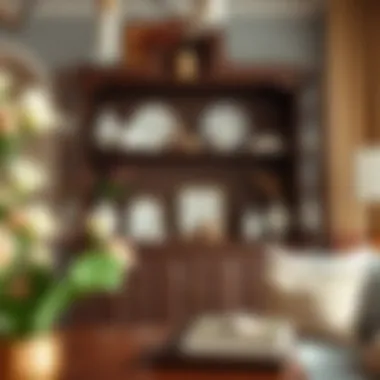
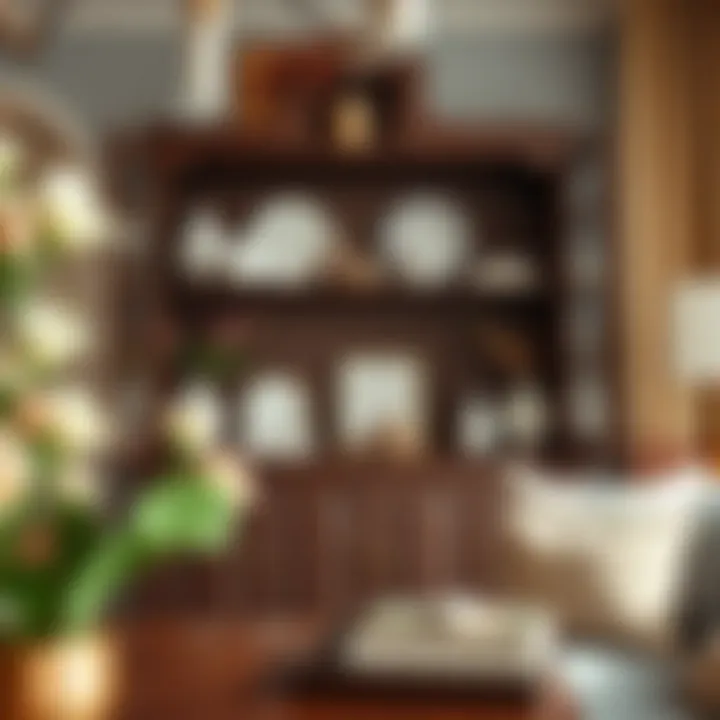
To help make this space assessment more organized, here's a simple checklist:
- Measure Floor Space: Use a tape measure to note the area. Ensure you have clearance for opening the doors and drawers.
- Notice Ceiling Height: A tall hutch can make a small room feel cramped. Be mindful of the proportions.
- Understand Traffic Patterns: How will people move around the hutch? Make sure those pathways are kept clear.
By taking the time to measure and assess, you can avoid the potential headache of purchasing a hutch that simply doesn’t fit.
Style Compatibility
Once you've nailed down your space parameters, it’s time to consider style compatibility. The hutch shouldn’t just fit physically; it should also fit stylistically with the decor of your home. When it comes to style, options are plentiful—from traditional to contemporary designs.
To find the right match, ponder these questions:
- What is the dominant style of the room? Is it rustic, minimalist, or maybe something in between?
- What color palette do you have in place? The hutch should complement, not clash with, your existing colors.
- Does it align with your personal taste? Trends are great but choose a style that you will love for years.
Examples of Popular Styles:
- Traditional: Crafted designs that evoke warmth and nostalgia.
- Modern: Sleek lines with less fuss, focusing on functionality.
- Farmhouse: A cozy vibe with reclaimed materials often providing character.
Choosing a hutch that fits well with your existing decor can create a unified feel in your home.
Budget Constraints
Lastly, one cannot overlook budget constraints when considering a china hutch. This piece can be a significant investment, so establishing a clear budget before shopping is paramount. Understand that price can fluctuate greatly influenced by materials, brand, and craftsmanship.
You can break down your budget into several categories:
- Material Quality: Solid wood generally comes at a higher price than manufactured options, yet the longevity it offers can justify the cost.
- Brand Reputation: Sometimes you pay for the reputation. Established brands may offer warranties, goodwill, and assurance of quality.
- Condition: If you’re considering vintage options, keep an eye out for wear and tear, which can affect pricing.
Also, consider the hidden costs of ownership, such as maintenance and potential repairs. Always approach your search with a clear budget in mind, as this clarity helps guide you toward more suited options without overspending.
Choosing the right china hutch is a multi-faceted process that involves measuring space accurately, analyzing style compatibilities, and sitting down with a budget. Each aspect plays a role in ensuring that your selection enhances both function and form in your home.
Care and Maintenance
Taking care of your china hutch is not just about preserving a piece of furniture; it’s about protecting a part of your home’s heritage and aesthetic appeal. With various designs and materials used in china hutches, understanding proper care and maintenance practices is crucial for longevity and functionality. In this section, we will explore both cleaning techniques and regular maintenance practices to ensure your hutch remains as splendid as the treasures it holds.
Cleaning Techniques
Cleaning a china hutch requires a delicate touch. Here are some effective methods to keep it spotless and shiny:
- Dusting: Use a soft, dry microfiber cloth to gently remove dust from surfaces. Avoid using feather dusters, as they can drive dust into small crevices where it might accumulate.
- Soapy Water: For tougher grime, a mixture of mild dish soap with warm water works wonders. Dampen a cloth with the solution, wring it out thoroughly, and wipe down the exterior. Always follow up with a clean, damp cloth to remove any soap residue.
- Glass Surfaces: For glass doors, a streak-free cleaner or a mixture of vinegar and water can be effective. Use newspaper or a lint-free cloth to achieve a clear finish without leaving behind fibers.
- Avoid Harsh Chemicals: Steer clear of any strong solvents or abrasive cleaners, as these can damage the finish of your china hutch.
"An ounce of prevention is worth a pound of cure." Regular cleaning can save you time and effort down the line, keeping your hutch looking pristine.
Regular Maintenance Practices
Regular maintenance can make a significant difference in preserving your china hutch's beauty and utility. Here are key practices:
- Periodic Inspections: Every few months, take the time to inspect your hutch for any signs of wear, such as cracking or loosening joints. Early detection can save you from more significant repairs later.
- Humidity Control: Monitor the humidity levels in the room. Extreme fluctuations can cause wooden hutches to expand and contract, leading to cracks. A stable environment helps maintain the integrity of the materials.
- Re-oiling or Resealing: Wooden hutches often benefit from a periodic application of oil or a protective sealant to maintain their luster. If your hutch has been looking dull, consider applying a quality furniture polish that matches the wood type.
- Proper Use of Doors and Drawers: Always open doors and drawers gently. Avoid slamming them, as this can misalign the structure over time. Regularly check hinges and runners to ensure they’re in good working order.
Caring for your china hutch doesn’t need to be a daunting task, but it requires consistent attention. With the correct techniques and practices, you can uphold its value and artistic charm for years to come.
Trends in China Hutches
Understanding the trends in china hutches is crucial for anyone looking to buy or design a unique piece for their home. The beauty of a china hutch lies not only in its decorative prowess but also in its evolving functionality within modern living spaces. As lifestyles shift and sensibilities change, so do the design and utility of this timeless furniture piece.
Sustainable Practices in Production
Today, more and more consumers are leaning towards sustainability, which has, in turn, impacted furniture design and production. When it comes to china hutches, this trend underscores the significance of ethical sourcing and environmentally friendly manufacturing processes. Many manufacturers now prioritize reclaimed or sustainably sourced materials. This shift is not just about keeping up with consumer demand; it's an ethical commitment to preserving our planet for future generations.
- Reclaimed Wood: By using wood that has been salvaged from old buildings or furniture, artisans provide a distinct character to each hutch while helping to reduce waste.
- Eco-Friendly Finishes: You can also find hutches that are finished with non-toxic paints or varnishes. This not only protects the environment but also ensures a healthier home environment, contributing to better air quality.
"Investing in sustainable furniture isn’t merely a trend; it’s a lifestyle choice that reflects awareness and responsibility towards the environment."
By purchasing a hutch that embraces these sustainable practices, homeowners not only bring a unique piece into their space but also contribute to a larger movement that values sustainability.
Customizable Options
Customization is on the rise and, with china hutches, it opens a world of possibilities. Modern consumers appreciate furniture that uniquely aligns with their personal taste and home aesthetic. Customizable options in china hutches cater to individual preferences in a way that mass-produced furniture simply can’t.
Here are some common customizable features:
- Size Variability: Whether your space is cozy or spacious, you can adjust the size of the hutch to fit perfectly.
- Finish Selection: Choose from a variety of stains, paints, or natural finishes to complement your interior decor.
- Shelf Configurations: Opt for adjustable shelves or specific layouts that cater to your collection, whether it be china, glassware, or other display items.
The shift towards customizable options elements cannot be overstated. It gives homeowners a sense of agency over their interiors, allowing them to craft a home that is a true reflection of themselves. These personalized hutches don’t merely serve as furniture; they become a centerpiece of family gatherings and a repository of cherished memories.
Finale
In the vast domain of interior design, the china hutch emerges as more than just a piece of furniture; it holds an essential narrative connecting history, culture, and aesthetic appeal. This article has journeyed through its evolution, highlighting the myriad of designs and materials that define the china hutch's versatility.
Final Thoughts on the China Hutch
The value of the china hutch today is rooted not only in practical storage but also in its ability to enhance the visual harmony of any room. As interior designers and homeowners look to balance functionality with style, the choice of a china hutch often becomes a defining aspect of a living space. These units can serve as anchors in dining rooms, showcasing heirloom dinnerware or contemporary glassware against beautifully lit backdrops.
The practical benefits of incorporating a china hutch into a home include:
- Efficient storage solutions that maximize space utilization.
- Serving as a central point around which gatherings revolve, evoking warmth and conversation.
- Offering an opportunity to express personal style through interior decor choices, such as color, material, and arrangement.
However, one must also consider the selection process—space dimensions, style compatibility, and budget constraints are all critical factors. The hutch should resonate with the overall aesthetic of the home while fitting snugly into the designated area without overcrowding.
Ultimately, understanding the china hutch’s role allows both homeowners and stylists to make informed choices that enhance not only the visual allure of their space but also contribute to creating a habitat that is inviting and uniquely personal. The dynamics of function and design encapsulated in this traditional furniture piece continue to evolve, ensuring that the china hutch holds a cherished place in both modern and traditional decor.



